Alexander 2.14
Alexander the Great (*356; r. 336-323): the Macedonian king who defeated his Persian colleague Darius III Codomannus and conquered the Achaemenid Empire. During his campaigns, Alexander visited a.o. Egypt, Babylonia, Persis, Media, Bactria, the Punjab, and the valley of the Indus. In the second half of his reign, he had to find a way to rule his newly conquered countries. Therefore, he made Babylon his capital and introduced the oriental court ceremonial, which caused great tensions with his Macedonian and Greek officers.
The return
The southern Punjab
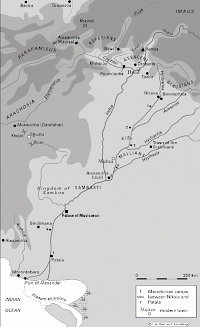
Alexander had decided to return, but how? The easiest route would be to go to the kingdom of Porus, Pauravas, to Taxila and Gandara; it would not be too difficult to reach Alexandria in the Caucasus, where his army had started its expedition to India. On the other hand, this would look as if the Macedonians returned after a defeat. So, the Macedonian supreme command decided that it was best t go to the Ocean, and to ship the army back to Persis and Babylonia.
However, the army first had to march to the west, until the soldiers reached the Hydaspes again at the end of September. Here, Alexander had founded two cities, Nicaea and Bucephala, and in the river part, many ships were already assembled. But extra ships had to be built, and it took some time before the expedition to the south could begin. Alexander's admiral was Nearchus, who was to write a book about the expedition (the Indikê), mentions Alexander's most important courtiers, because he gives a list of "trierarchs" who were responsible for the building of the transport ships (list). Phoenicians, Carians, Cypriotes and Egyptians were to row the 800 ships. According to a modern estimate, the size of the army and its train was by now that of a major town, about 100,000 men.
It was November and the monsoon period was over. Alexander sacrificed to the river gods, his legendary ancestor, the demigod Heracles and the Egyptian god Ammon, and the ships could finally leave. The fleet was escorted by two armies, commanded by Craterus and Hephaestion, marching along the banks in the west and east. The ships had been traveling for ten days, when disaster overtook them. At the confluence of the Acesines and Hydaspes, several ships were thrown out of control, and many people lost their lives.
The Mallians
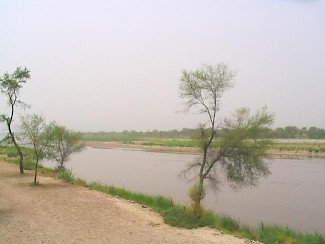
The Macedonian army had already visited densely populated, urbanized countries in river valleys. In Egypt and Babylonia, the population had not resisted them. The nations along the Indus, however, offered resistance. In January 325, Alexander's men had to fight themselves a way through the countries of the Mallians (Indian Mâlava), who lived near modern Multan, and the Oxydracae (Ksudraka), who cannot be localized with any certainty.
The war was merciless and comparable to the genocide in Gandara (above). Craterus still commanded an army in the west, Hephaestion and Ptolemy commanded two armies in the east, and Alexander commanded the main force, the Companion cavalry, the Dahan mounted archers and a part of the phalanx. Several Mallian towns - perhaps modern Kamalia and Talamba - were attacked and captured, and those who tried to escape were caught by the other armies.
During the siege of the capital of the Mallians, modern Multan, Alexander was seriously wounded by an arrow; he owed his survival to Abreas - who had been killed - and Peucestas, and a bodyguard named Leonnatus, who protected the king with the sacred shield of Troy (above). The wound was very serious. For the rest of his life, the son of Zeus Ammon was to suffer pain, because the arrow had penetrated his lung.
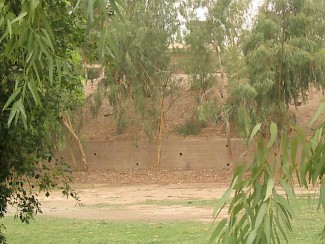
Nonetheless, the last of the Mallians surrendered, soon followed by the demoralized Oxydracae. From his sick bed, Alexander ordered the establishment of a new satrapy, which was to be ruled by a Macedonian named Peithon and Oxyartes, the father of Roxane. He also founded a new town, Alexandria, near the confluence of the Indus and the Acesines, probably on the site of an older, Persian settlement. Thracian veterans and natives were to live here, not far from modern Uch. (Here, a famous contest took place between a Greek and a Macedonian soldier, which created great tensions in Alexander's army: text.) Like the cities he had already founded on the Hydaspes, Nicaea and Bucephala, the city possessed large dockyards, which suggests that Alexander wanted to develop the Indus valley. A new town was founded in the country of the Sogdians; this was to be the capital of the new satrapy.
Sind
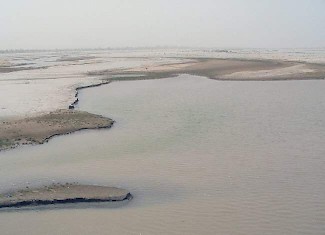
The ruler of the next kingdom, Musicanus (Indian Mûshika), failed to pay homage to the conqueror, which gave Alexander the excuse he needed to invade the country he had to cross anyway, which was called Sindhu. Musicanus surrendered and received his new overlord in his capital, modern Alor. Alexander immediately attacked Musicanus' neighbor, king Oxicanus, who reigned near modern Sukkur.
Going southward, Alexander also attacked the kingdom of king Sambus (Sambhu), which was situated between the Kirthar range and the Indus. Its capital Sindimana has been identified with modern Sehwan.
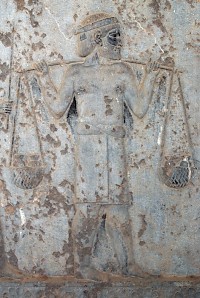
When Alexander wanted to continue to the nearby sea in April, the states in his rear revolted. The rebellion was inspired by the Brahmans, who seem to have had some kind of academy in a town called Harmatelia. The Macedonians killed many rebels; the Brahmans were hanged and king Musicanus, who had supported the revolt, was crucified. King Sambus escaped. The Brahman rebellion spread to the northern regions as well; the satrap of Gandara was killed, but eventually, the Macedonian garrison pacified the country.
Preparing to return
One of the armies that was sent out to suppress the rebellions was commanded by Craterus, and was under orders to continue to the west, through the Bolan pass to Carmania and Persis. He commanded about a third of the army, including the war elephants; this means that Alexander did not want to expose all his men to the dangers that were ahead. After all, a large part of them would have to march through the Gedrosian desert, others were to sail along the almost unknown shores of the Indian Ocean and Persian Gulf. At the same time, Craterus' honorable command was a way to keep the conservative general away from the royal court (above).
His army was probably not the first to return to the west. The Astronomical diaries kept in the Esagila temple at Babylon mention that in August 325, large quantities of gold arrived in Babylon. It was used for the making of a crown for the supreme god Marduk. This precious metal must have come from India, which was rich in gold, and it is not likely that the transport was unguarded. It is plausible, therefore, to assume that some troops had been sent home in, say, November 326, when the main force boarded the ships.
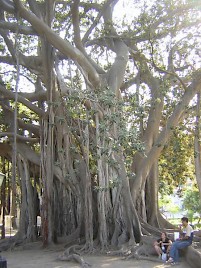
The monsoon season was approaching again, and the Macedonians must have felt relieved when they finally reached the Indian Ocean. In their world view, the Ocean was the sea that surrounded the earth. They had reached the legendary edges of the earth, where the tide swept over large stretches of land, as if there was an everlasting struggle about whether this region belonged to the land or to the sea.
Again, a town was built, probably on the site of an older, Indian town. It was called Patala (Indian for "naval base") or Xylinepolis (Greek for "wooden city") and seems to be identical to modern Bahmanabad, 75 kilometers north of Hyderabad. Here, the fleet was refitted for the return voyage. The shores of the Indian Ocean were not unknown, because the Carian captain Scylax of Caryanda had explored them in the age of the Persian king Darius I the Great. However, it was risky to send a great many ships and soldiers out across the open sea. A reconnaissance operation, commanded by Alexander in person, turned out to be dangerous, because the captains did not understand the tides very well. Nonetheless, Alexander could claim to have sailed on the Ocean.
The Gedrosian desert
In August, Alexander and three quarters of the army - 50,000 to 60,000 men - left Patala and started for Carmania. During their march, they built a large grain store, where Nearchus and the remaining quarter (17,000 to 20,000 men) under his command could resupply themselves. Alexander's men first defeated the Oreitans ("mountain people"), the native population, and Hephaestion, who commanded the baggage train, was ordered to build a new city, Rhambaceia (modern Las Bela). Leonnatus was left behind to defend the region; after all, Nearchus still had to pass along the shore and the grain store had to be kept intact.
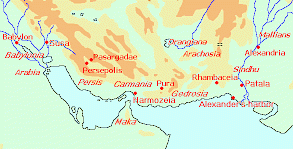
Meanwhile, admiral Nearchus was still in Patala. But now that Alexander had left, the Oreitans were no longer afraid to renew their attacks. On 15 September, Nearchus was forced to leave his base and moved to the sea. At more or less the same time, the satrap of the region, Peithon, went to the Punjab, where he was reappointed as satrap. In fact, southern India was given up. (The story of the adventures of Nearchus is told here.)
The region that the Macedonian army entered in the first days of October was called Gedrosia and is more or less equivalent to modern Beluchistan. Alexander knew that king Cyrus the Great (r.559-530), the founder of the Achaemenid empire, had once lost an army in the Gedrosian desert. It is therefore surprising that he decided to take the risk of crossing through this country, especially because the Macedonians usually had excellent scouts. Perhaps the truth is that the son of Zeus thought that he would succeed where Cyrus, after all a mere mortal, had failed.
On the other hand, it should be stressed that Alexander was marching in the only period of the year when a crossing was possible. The monsoon rains had made the first part of the desert accessible, and the would arrive in Carmania when the harvest was ready. To benefit from these favorable conditions, Alexander and the main force had hurried through the country of the Oreitans and had left Hephaestion and Leonnatus behind to build Rhambaceia. Perhaps the disaster that befell the Macedonian army was, after all, unforeseen.
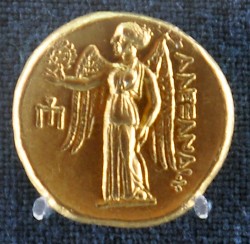
But a disaster it was. For sixty days, the army was marching through the desert, and the blazing heat and the lack of water caused innumerable casualties. Baggage animals had to be butchered. Probably the army itself remained relatively intact, but the concubines of the soldiers, the merchants and the other noncombatants seem to have suffered terribly form hunger and thirst (text). When rain started to fall, it was unexpected and people drowned in a flash flood.
Finally, the Macedonians reached Pura, modern Bampûr or Irânshahr, and their troubles were over. It was early December, and the winter rains were starting. Alexander had sent messengers to the satrap of Drangiana (one of the most fertile areas in Iran), who had sent food to Pura.
Alexander's army had suffered heavily, but the real victims, of course, were the natives. Especially those living on the coast were brutalized: first by Alexander's army, then by Nearchus' fleet.
Carmania
During his stay in Pura, news came from Craterus, who was - as we have already seen - commanding an army that was marching through Arachosia. It had suppressed a native rising. At the same time, Alexander learned about Leonnatus' fighting against the Oreitans. He must have understood that his grip on the eastern satrapies was not very strong. (His successor Seleucus eventually gave them up as part of an agreement with the new Mauryan Empire.)
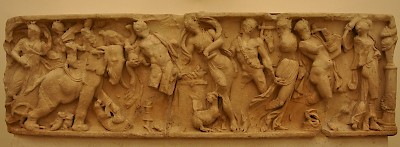
Alexander's army now moved to the west and entered Carmania, where the soldiers met the army of Craterus in the final days of 325. From now on, there was enough food. The satraps of Drangiana and Parthia had sent camels to bring food, the winter rains had started, and the harvest was ready. This was a time for celebration. Alexander dressed himself as the god of ecstasy, Dionysus, his mythological ancestor, and the rest of the army followed suit - everybody being in a state of drunken exaltation for seven days (text).

Having celebrated his survival from the ordeal in the Gedrosian desert, Alexander went back to business again. In January 324, he founded a new Alexandria (modern Golâshkerd in Iran) and heard the complaints of many Iranian nobles about their satraps, who had come to visit their king. Often, they were accused of sacrilege, which may be plausible, because the Greeks and Macedonians usually misunderstood Zoroastrianism and often unwillingly hurt the feelings of the native population. Many of them were found guilty and executed (text).
A harsher ruler
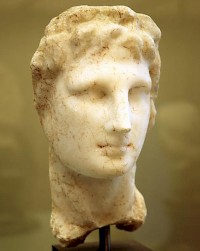
It is hard to interpret the executions. It is obvious that the satraps did not expect to be executed (otherwise, they would not have come). Several modern scholars have maintained that Alexander was a victim of paranoia, and had decided to kill possible rivals. Others have said that Alexander was an excellent ruler, who tried to restore order in the provinces of his empire. The truth may well be that Alexander did not know what to think of the accusations by the Iranian nobles, but understood that he had to show to the Iranians that he took them seriously. Perhaps innocent Macedonians were executed, but it served the purpose of winning over the Persians to Alexander's side. However this may be, it is understandable that the Greek historian Arrian of Nicomedia concluded that the rule of the son of Ammon became "harsher" (oxyteros).
At the same time, several satraps of Iranian descent were replaced by Europeans. For example, the satrap of Babylonia, Stamenes, who had died of natural causes, was replaced by a Macedonian named Archon.
Another measure was that Alexander ordered his satraps to disband their mercenary armies, and sent the soldiers to their king. This is interesting, because it illustrates that Alexander had left behind many Greeks in the new towns in the east and had lost many people in the Gedrosian desert, so that they needed to be replaced. Another benefit was that this measure also reduced the satrap's capacity to obstruct Alexander's orders.
In Carmania, Alexander met Nearchus, who had brought the fleet across the Indian Ocean to Harmozeia (modern Mînâb) without serious loss. The meeting was a joyful one, and a new meeting place was agreed upon: Susa. The army and the navy continued their way to the west.
Pasargadae
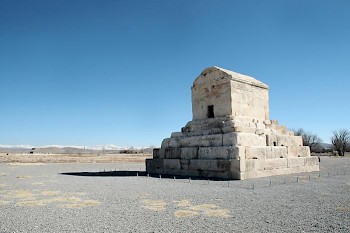
One incident deserves to be mentioned. Alexander visited Pasargadae, the religious capital of the Achaemenid empire. Here, the Persian kings were inaugurated near the tomb of Cyrus the Great. In 330, when Alexander had visited Persepolis and Pasargadae, he had wanted to be crowned according to the Persian rituals (described here), but this had not been possible because Darius III Codomannus had still been alive. If Alexander wanted to be crowned on his return from India, he was disappointed: the tomb was desecrated. Cyrus' body had been thrown to the floor, and there was no possibility to inaugurate Alexander (text). He ordered Aristobulus to restore the tomb, and at the end of January 324, he continued to Persepolis and Susa, where the army and navy were to reunite.
Alexander had returned to the heartland of his giant empire. Except for the eastern periphery, the borders were secure, and the king was fully in charge of the situation. He was thirty-one years old, and had only 500 days to live.